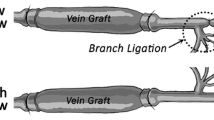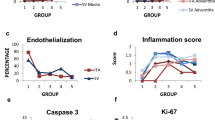Summary
End-to-end autogenous vein-to-artery grafts in rats have been used extensively as a model for neointimal thickening (hyperplasia), which develops over the first 6 weeks after grafting. This study employed computerised morphometric techniques to analyse 16 grafts, in order to quantitate precisely how the neointima develops. Two important features were described that have not been identified previously, due to the extensive variation in neo-intimal thickness inherent in vein grafts. Firstly, the proximal region of the graft was significantly thicker than the distal region, up until 6 months after grafting. The smooth muscle cells in the graft may have developed more rapidly in the proximal region, due to the altered haemodynamics within the graft. Secondly, within the central region of the graft the characteristic focal nature of neo-intimal hyperplasia was evident throughout the period of the study, but by 6 months the neo-intima tended to be distrubuted more evenly. By 6 months remodelling of smooth muscle throughout the graft neo-intima had occurred, and the neo-intima had matured to a thickness equivalent to that of the intima plus media of the adjacent iliac artery.
Similar content being viewed by others
References
Campbell GR, Campbell JH, Manderson JA, Horrigan S, Rennick RE (1988) Arterial smooth muscle. A multifunctional mesenchymal cell. Arch Pathol Lab Med 112:977–986
Dilley RJ (1986) The histogenesis of intimal hyperplasia in experimental vein to artery grafts in the rat. PhD thesis. The University of Western Australia Library
Dilley RJ, McGeachie JK, Prendergast FJ (1983) Experimental vein grafts in the rat: re-endothelialization and permeability to albumin. Brit J Surg 70:7–12
Dilley RJ, McGeachie JK, Prendergast FJ (1986) A morphometric study of vein graft intimal hyperplasia. Plast Reconst Surg 77:451–454
Dilley RJ, McGeachie JK, Prendergast FJ (1988) A review of the histologic changes in vein-to-artery grafts, with particular reference to intimal hyperplasia. Arch Surg 123:691–696
Dilley RJ, McGeachie JK, Tennant M (1992) The role of cell proliferation and migration in vein to artery graft intimal hyperplasia in rats. Cell Tissue Res 269:281–287
Galletti G, Gorolewski S, Ussia G, Farruggia F (1989) Long-term patency of regenerated neoaortic wall following the implant of a fully biodegradable polyurethane prosthesis: experimental lipid diet model in pigs. Ann Vasc Surg 3:236–243
Hort W, Burrig KF (1989) The endothelium and arteriosclerosis. Z Kardiol 78:105–112
Majack R, Cook S, Bornstein P (1986) Control of smooth muscle cell growth by components of the extracellular matrix: autocrine role of thrombospodin. Proc Natl Acad Sci USA 83:9050–9054
Marois Y, Guidoin R, Boyer D, Assayed F, Doillon CJ, Paynter R, Marois M (1989) In vivo evaluation of hydrophobic and fibrillar microporous polyetherurethane urea grafts. Biomaterials 19:521–531
McGeachie JK, Campbell P, Simpson S, Prendergast FJ (1982) Arterial vasa vasorum: a quantitative study in the rat. J Anat 134:193–197
McGeachie JK, Prendergast FJ, Morris PJ (1983) Vein grafts for arterial repair: an experimental study of the histological development of the intima. Ann R Col Surg Eng 65:85–89
McGeachie JK, Meagher S, Prèndergast FJ (1989) Vein-to-artery grafts: The long-term development of neo-intimal hyperplasia and its relationship to vasa vasorum and sympathetic innervation. ANZ J Surg 59:59–65
Muller-Hermelink HK, Dammrich JR (1989) Obliterative transplant vasculopathy: pathogenesis and pathologic mechanisms. Verb Dtsch Ges Pathol 73:193–206
Nerem RM, Shaw GM, Hosteller JR, Vasko JS (1978) Velocity distribution and intimal proliferation in autologous vein grafts in dogs. Circ Res 42:792–801
Nilsson J (1986) Growth factors and the pathogenesis of atherosclerosis. Atherosclerosis 62:185–199
Nilsson J, Sjolund M, Palmberg L, Thyberg J, Heldin CH (1985) Arterial smooth muscle cells in primary culture produce PDGF-like protein. Proc Natl Acad Sci USA 82:4418–4422
Ortenwall P, Wadenvik H, Risberg B (1989) Reduced platelet deposition on seeded versus unseeded segments of expanded polytetrafluoroethylene grafts: clinical observations after 6-month follow-up. J Vasc Surg 10:374–380
Polak JF, Donaldson MC, Whittemore AD, Mannick JA, O'Leary DH(1989) Pulsatile masses surrounding vascular prostheses: real-time US color flow imaging. Radiology 170:363–366
Prendergast FJ, McGeachie JK, Fabre JW, Winearls CG, Morris PJ (1979) Vein allografts for arterial replacement in rats. Transplantation 27:49–54
Risau W, Zerwes HG (1989) Role of growth factors in the formation of blood vessels. Z Kardiol 78:9–11
Ross R (1986) The pathogenesis of atherosclerosis — an update. New Eng J Med 314:488–499
Ross R, Glomset JA (1976a) The pathogenesis of atherosclerosis (part 1). New Engl J Med 295:369–375
Ross R, Glomset JA (1976b) The pathogenesis of atherosclerosis (part 2). New Engl J Med 295:420–425
Ross R, Vogel A (1978) The platelet-derived growth factor. Cell 14:203–210
Seifert RA, Schwartz SM, Bowen-Pope DF (1984) Developmentally regulated production of platelet-derived-growth factor-like molecules. Nature 311:669–671
Storrie EA, McGeachie JK, Samuels R, Hunneybun B, Bartlett N (1990) Transverse or longitudinal artetiotomies in end-to-side microvascular anastomoses. Microsurgery 11:108–113
Tennant M, McGeachie JK (1991) A computerised morphometric technique for the analysis of intimal hyperplasia. J Anat 178:119–126
Tennant M, McGeachie JK, Dilley RJ, Prendergast FJ (1990) Histogenesis of arterial intimal hyperplasia and atherosclerosis. ANZ J Surg 60:79–85
Uchida N, Emotot H, Kambic H, Harasaki H, Chen JF, Hsu SH, Murabayashi S, Nose Y (1989) Compliance effect on patency of small diameter vascular grafts. ASAIO Trans 35:556–558
Walker LN, Bowen-Pope DF, Ross R, Reidy MA (1986) Production of platelet-derived growth factor-like molecules by cultured arterial smooth muscle cells accompanies proliferation after injury. Proc Natl Acad Sci USA 83:7311–7315
Author information
Authors and Affiliations
Rights and permissions
About this article
Cite this article
Tennant, M., McGeachie, J.K. Adaptive remodelling of smooth muscle in the neo-intima of vein-to-artery grafts in rats: a detailed morphometric analysis. Anat Embryol 187, 161–166 (1993). https://doi.org/10.1007/BF00171748
Accepted:
Issue Date:
DOI: https://doi.org/10.1007/BF00171748




